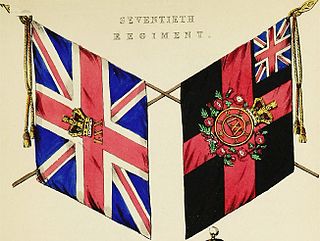The 77th Regiment of Foot was a Highland Scots Regiment raised in 1757. The 77th Regiment was one of the first three Highland Regiments to fight in North America. During the Seven Years' War, the regiment lost 110 soldiers and 259 were wounded.

General Lord George Henry Lennox was a British Army officer and politician who sat in the House of Commons from 1761 to 1790.
The 78th Regiment, (Highland) Regiment of Foot also known as the 78th Fraser Highlanders was a British infantry regiment of the line raised in Scotland in 1757, to fight in the Seven Years' War. The 78th Regiment was one of the first three Highland Regiments to fight in North America.

The 55th Regiment of Foot was a British Army infantry regiment, raised in 1755. After 1782 it had a county designation added, becoming known as the 55th (Westmorland) Regiment of Foot. Under the Childers Reforms it amalgamated with the 34th (Cumberland) Regiment of Foot to form the Border Regiment in 1881.

The 70th (Surrey) Regiment of Foot was a regiment of the British Army, raised in 1756. Under the Childers Reforms it amalgamated with the 31st (Huntingdonshire) Regiment of Foot to form the East Surrey Regiment in 1881.
The 66th (Berkshire) Regiment of Foot was an infantry regiment of the British Army, raised in 1756. Under the Childers Reforms it amalgamated with the 49th (Hertfordshire) Regiment of Foot to form the Princess Charlotte of Wales's in 1881.
The 69th Regiment of Foot was an infantry regiment of the British Army, raised in 1756. Under the Childers Reforms it amalgamated with the 41st (Welch) Regiment of Foot to form the Welch Regiment in 1881.
The 61st Regiment of Foot was an infantry regiment of the British Army, raised in 1756. Under the Childers Reforms it amalgamated with the 28th Regiment of Foot to form the Gloucestershire Regiment in 1881.
The 74th Regiment of Foot was an infantry regiment of the British Army from 1758 to 1763.
Four regiments of the British Army have been numbered the 75th Regiment of Foot:
Four regiments of the British Army have been numbered the 71st Regiment of Foot:
Four regiments of the British Army have been numbered the 73rd Regiment of Foot:
Four regiments of the British Army have been numbered the 61st Regiment of Foot:
71st Regiment may refer to:
Seventy-First Township is a civil township in Cumberland County, North Carolina. The township was named from the Scottish immigrants who were descendants of the 71st Regiment of the Royal Army. The 71st Regiment of Foot was first formed in 1758 from the 2nd Battalion, 32nd Regiment of Foot. Soon after formation the 71st Foot was part of a raid on the French coast at Cherbourg during the Seven Years' War. After taking the fort and destroying the docks the regiment reboarded and returned to England before it took part in a similar raid on Belleisle in 1761. In 1763 the 71st became a Regiment of Invalids before disbanding in 1768. The regiment was raised again at Inverness, Stirling and Glasgow by Lieutenant-General Simon Fraser of Lovat as the 71st Regiment of Foot in 1775. It was intended for service in the American Revolutionary War and was well received in Glasgow: "Their conduct was so laudable and exemplary as to gain the affections of the inhabitants, between whom and the soldiers the greatest cordiality prevailed." The regiment embarked for North America in April 1776, fought in New York at the Battle of Long Island, Brandywine in 1777, Savannah in 1778. The regiment was also present at the Siege of Charleston in March 1780, the Battle of Camden in August 1780 and the Battle of Cowpens in January 1781. It next fought at the Battle of Guilford Court House in March 1781 where one officer of the 71st Regiment claimed that "one half of the Highlanders dropped on that spot." The regiment's last action was at the Siege of Yorktown in September 1781.
The 75th Regiment of Foot was an infantry regiment of the British Army from 1758 to 1763.
The 76th Regiment of Foot was a regiment of the British Army from 1756 to 1763.
The 73rd Regiment of Foot was a regiment in the British Army from 1758 to 1763. It was formed on 28 April 1758 from the 2nd Battalion of the 34th Regiment of Foot, and served in Ireland until it was disbanded in 1763.
The 72nd Regiment of Foot was a regiment in the British Army from 1758 to 1763.
The 86th Regiment of Foot was a short-lived infantry regiment in the British Army which was raised in 1758, during the Seven Years' War with France, by redesignation of the 2nd Battalion, 61st Regiment of Foot.


